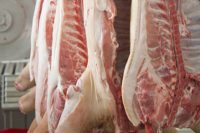Greater shopper interest in healthier and safer eating is triggering changes in the production and merchandising of ground meat and poultry.
Traditionally a major meat department revenue generator, the grinds sector is becoming increasingly active as suppliers and retailers aggressively respond to evolving consumer treads. That includes merchandising higher-quality proteins with cleaner labels.
“More consumers want fresher grinds that come from local producers,” says Keith Belk, a professor in the Center for Meat Safety and Quality at Colorado State University in Fort Collins. “There also is increasing interest in organic products and higher grades of meat.”
Organizations that respond to such demands are in position to bolster activity in an already vibrant ground meat sector.
Retail revenues for ground beef hit $10.4 billion in 2015, a 9.9 percent increase from the year-earlier period, with unit sales up 2.4 percent to 2.4 billion, the Beef Checkoff reports in The Power of Meat 2016. The Beef Checkoff is a producer-funded marketing and research program design to increase demand for beef.
Grinds account for 42 percent of overall beef dollar revenues and 52 percent of pound sales, and category growth is exceeding that of the total beef sector. Industry-wide pound sales rose just 0.4 percent in 2015 with revenues up 7 percent.
Ground beef had an average retail price of $4.29 a pound in 2015, up 7.3 percent from a year earlier. The average beef price for all categories was $5.29 a pound, up 6.6 percent.
The Beef Checkoff attributes the popularity of grinds to the products’ greater affordability, ground meats’ versatility as an ingredient and the convenience of cooking with grinds.
Giving ground to grinds
The lower cost of ground meats is leading more consumers to buy top-quality selections in lieu of steaks and other traditionally higher-priced cuts, says Jamie Schweid, president and CEO of Schweid & Sons, a Carlstadt, N.J.-based ground beef purveyor.
“Demand for premium grinds is increasing,” he says. “Ground beef is moving from a one-size-fits-all model to more customized blends, which includes the greater use of sirloin.”
More producers, meanwhile, are updating their technologies and processes to enhance ground meat quality. That includes reducing the handling and treatment of the proteins and providing less pressure to meats in grinding and forming equipment, Schweid says.
“The more producers overwork meat, the worse effect there is on the texture and that results in a poorer eating experience,” he says, noting meat often can be ground three or four times during the production cycle.
It also is crucial that producers monitor temperatures and keep meat and poultry at 28 to 30 degrees during the grinding, packaging and storage stages in order to extend shelf life and enhance texture and taste, he says.
“There is always the issue of working against the clock when dealing with fresh meat,” Schweid says. “The meat must be ground quickly as the longer it is exposed to air, the faster the quality declines.”
Better meats through mechanics
Along with leveraging more effective operating procedures, producers are incorporating state-of-the-art automation.
Designs are resulting in less mixing of proteins to retain product quality and the greater ability of operators to detect hard materials in meat through the use of x-ray and near-infrared (NIR) technologies, says Brett Chambers, operations lead for ground beef for Wichita, Kan.-based protein supplier Cargill Inc.
There also is more coating covering grinding plates to help keep the plates sharper longer, he says.
“The new technologies also contribute to better fat analysis as well as cleaner cuts for meat grinds,” Chambers says.
Cargill, meanwhile, is enhancing its poultry operation by processing ground turkey with grinding plates that contain holes in different configurations.
The methodology — which Cargill uses in lieu of high-pressure systems that push meat through screens — is less aggressive and results in a product that is less tacky and shear and can withstand the grind process better, says David Hyde, operations advisor for Cargill turkey and cooked meats.
Ongoing concerns when producing ground turkey, he adds, are the need to prevent meat temperatures from rising prior to grinding and maintaining the quality and integrity of raw materials.
“We anticipate technologies in the future will help with these challenges,” Hyde says.
In the meantime, Chambers says it is important for processors to consistently review grind quality and operating efficiencies throughout the production process. That includes monitoring temperatures and maintenance practices to ensure equipment is performing at its optimum capabilities.
“Continuous training for employees, including operators and maintenance personnel, also is important,” he says.
The final package
Other techniques for enhancing product quality include developing and packaging ground meats in chubs and other case-ready formats at central locations, Belk says, noting that such procedures can augment the taste and shelf life of the proteins while enhancing food safety.
Central packaging can help reduce the propensity to grind meats multiple times throughout the production chain, while also diminishing the threat of cross-contamination and having foreign particles in the final product.
“Many retailers are working harder at trying to make consumers feel comfortable with these centrally packaged grinds and the shoppers are becoming more receptive,” Belk says.
While the proper equipment and production techniques are crucial elements of an efficient grinding operation, using the best cuts of meats is perhaps the most important component, Schweid says.
He notes operators that skimp on quality face the threat of a shopper backlash.
“There always is an opportunity to save a penny here or there during production,” he says. “But customers are smart and educated and they will respond appropriately to the products they receive. Companies that focus on the core components — which include the right quality of meat, blend time and environmental temperature — can make a great quality product.” NP





Report Abusive Comment